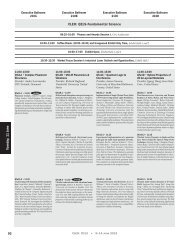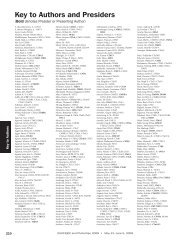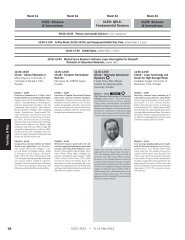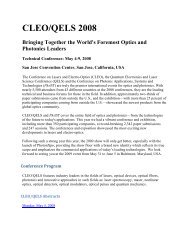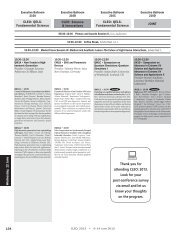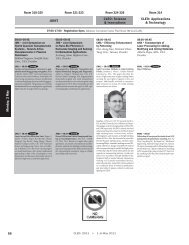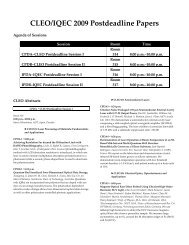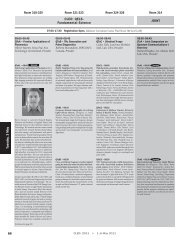Create successful ePaper yourself
Turn your PDF publications into a flip-book with our unique Google optimized e-Paper software.
Rooms 318-320 Rooms 321-323 Rooms 324-326 Room 314<strong>CLEO</strong>IQEC<strong>CLEO</strong>IQECCMHH • Novel Applicationsof Microstructured Films—ContinuedIMJ • Quantum Information III—ContinuedCMII • High Repetition RateCombs—ContinuedIMK • NanoplasmonicWaveguides and Devices—ContinuedCMHH4 • 4:45 p.m.Colorful Photonic Band Gap Fiber-BasedTextiles, Bertrand Gauvreau 1 , Ning Guo 1 , KathyShicker 2 , Karen Stoeffler 1 , F. Boismenu 1 , AbdellahAjji 3 , Charles Dubois 1 , Maksim Skorobogatiy 1 ;1École Polytechnique de Montréal, Canada, 2 Univ.of the Arts, UK, 3 Industrial Materials Inst., Canada.Polymer Bragg fiber-enabled, color changingphotonic textiles are demonstrated. Such textilesshow intrinsic and uniform lateral light extractionand evolutive visuals using both passive and activecolor control.CMII4 • 4:45 p.m.Frequency Stabilized Mode-Locked Laserwith 1000 Finesse Intracavity Etalon, IbrahimT. Ozdur, Sarper Ozharar, Mehmetcan Akbulut,Franklyn Quinlan, Dimitrios Mandridis, PeterJ. Delfyett; CREOL and FPCE, College of Opticsand Photonics, Univ. of Central Florida, USA. Alow noise, frequency stabilized, semiconductorbased, 10.287 GHz mode-locked laser with 1000finesse intracavity etalon is demonstrated with atiming jitter (1Hz-100MHz) of 10.9 fs and opticalfrequency fluctuations less than 150 kHz.IMK5 • 4:45 p.m.Practical Limits of Absorption Enhancementnear Metal Nanoparticles, Greg Sun 1 , Jacob B.Khurgin 2 ; 1 Univ. of Massachusetts at Boston, USA,2Johns Hopkins Univ., USA. We study the enhancedabsorption of optical radiation by moleculesplaced near metal nano-particles that includesperturbation of the optical field and show that theenhancement is strong only for relatively weak anddiluted absorbers.<strong>Monday</strong>, <strong>June</strong> 1CMHH5 • 5:00 p.m.All-Fiber Laser Cavity Dumping, Zhangwei Yu 1,2 ,Walter Margulis 1,2 , Oleksandr Tarasenko 2 , MickeMalmström 1,2 ; 1 Royal Inst. of Technology, Sweden,2Acreo AB, Sweden. Cavity dumping of a fiber laseris demonstrated. A microstructured fiber with anelectrically driven internal electrode is used forintracavity polarization rotation with nanosecondrisetime. The optical flux can be dumped withinone roundtrip.CMHH6 • 5:15 p.m.Mode Structure of Large Mode Area All-SolidPhotonic Bandgap Fiber, Sergei L. Semjonov 1 ,Olga N. Egorova 1 , Andrew D. Pryamikov 1 , DmitryA. Gaponov 1 , Alexander S. Biriukov 1 , EvgenyM. Dianov 1 , Mikhail Y. Salganskii 2 , Vladimir F.Khopin 2 , Alexey N. Guryanov 2 ; 1 Fiber Optics Res.Ctr., Russian Federation, 2 Inst. of Chemistry of High-Purity Substances, Russian Federation. We analyzeoptical properties of all-silica photonic bandgapfibers with an ultra low ratio of the cladding rodsdiameter to the center-to-center distance. Opticalproperties similar to those of LMA holey fibersare revealed.Philippe Grangier’s research activities began in1980 about the realization of experimental tests ofBell’s inequalities, under the direction of Alain Aspect.He then worked on the generation of singlephotonstates (1986), squeezed-light-enhancedinterferometer and pulsed squeezed light (1987),quantum non-demolition (QND) measurementsin optics (1991-1998), and reducing the quantumnoise of semiconductor lasers (1995-1999). Inthe last few years, his research has been centeredon Quantum Information Processing and Communications,such as the implementation of newprotocols for quantum key distribution, and themanipulation of individual atoms in microscopicdipole traps (optical tweezers). Philippe Grangieris author or co-author of about 150 publicationsin international journals. He has been involvedin many European projects or networks in thedomains of Quantum Optics and Quantum InformationProcessing, and he is presently coordinatorof the large scale European Integrated ProjectSCALA (Scalable Quantum Computing with Lightand Atoms, 2005-<strong>2009</strong>).CMII5 • 5:00 p.m.Low Finesse Fabry-Perot Cavities for WideSpaced Frequency Combs with Large SpectralBandwidth, Tilo Steinmetz 1 , Tobias Wilken 1 ,Ronald Holzwarth 1 , Theodor W. Hänsch 1 , ThomasUdem 1 , Constanza Araujo-Hauck 2 ; 1 Max-Planck-Inst. für Quantenoptik, Germany, 2 EuropeanSouthern Observatory, Germany. We use lowfinesseFabry-Perot-cavities in series to generatefrequency-combs with large mode spacingby simultaneously maintaining high spectralbandwidth. The suppression of the neighboringfundamental mode of the frequency comb exceeds70dB for 5GHz cavities.CMII6 • 5:15 p.m.High Dynamic Range Optical System for DirectDetection of Exo-Planets by UnbalancedNulling Interferometer and Adaptive Optics,Kaito Yokochi 1 , Jun Nishikawa 2 , Naoshi Murakami 2 ,Lyu Abe 3 , Takayuki Kotani 4 , Motohide Tamura 2 ,Alexander V. Tavrov 5 , Mitsuo Takeda 6 , TakashiKurokawa 1 ; 1 Tokyo Univ. of Agriculture and Technology,Japan, 2 Natl. Astronomical Observatoryof Japan, Japan, 3 Univ. de Nice-Sophia Antipolis,France, 4 Observatoire de Paris, France, 5 Space Res.Inst. RAS, Russian Federation, 6 Univ. of Electro-Communications, Japan. We demonstrated amagnification of a wavefront aberration by anunbalanced nulling interferometer, and correctionof the aberration by the phase amplitude correctionfor precise wavefront correction beyond anadaptive optics performance limit.IMK6 • 5:00 p.m.Ultrashort Optical Pulse Propagation in MetalNanoparticle Covered Dielectric Surfaces, JessM. Gunn, Scott H. High, Vadim V. Lozovoy, MarcosDantus; Michigan State Univ., USA. We characterizethe behavior of optical pulse propagation insurfaces covered with silver metal nanoparticlesand quantify the dispersion introduced as thepulse propagates.IMK7 • 5:15 p.m.Giant Modal Gain in a Metal-SemiconductorWaveguide, Debin Li, Cun-Zheng Ning; ArizonaState Univ., USA. We show that a giant modal gainis achievable near surface plasmon resonance forguided modes in a metal-semiconductor-metalplasmonic waveguide. The giant gain is shownto originate from a reduction of average energyvelocity.6:00 p.m.–7:30 p.m. <strong>CLEO</strong> Plenary Session, Baltimore Convention Center, Ballrooms III-IVNOTES________________________________________________________________________________________________________________________________________________________________________________________________________________________________________________________________________________________________________________________________________________________________________________________________________________________________________________________________________________________________________________________________________________________________________________________________________________________________________________________________________________________________________________________________________________________________________________________________________________________________________________________________________________________________________________________________________76<strong>CLEO</strong>/IQEC and PhotonXpo <strong>2009</strong> • May 31–<strong>June</strong> 5, <strong>2009</strong>



